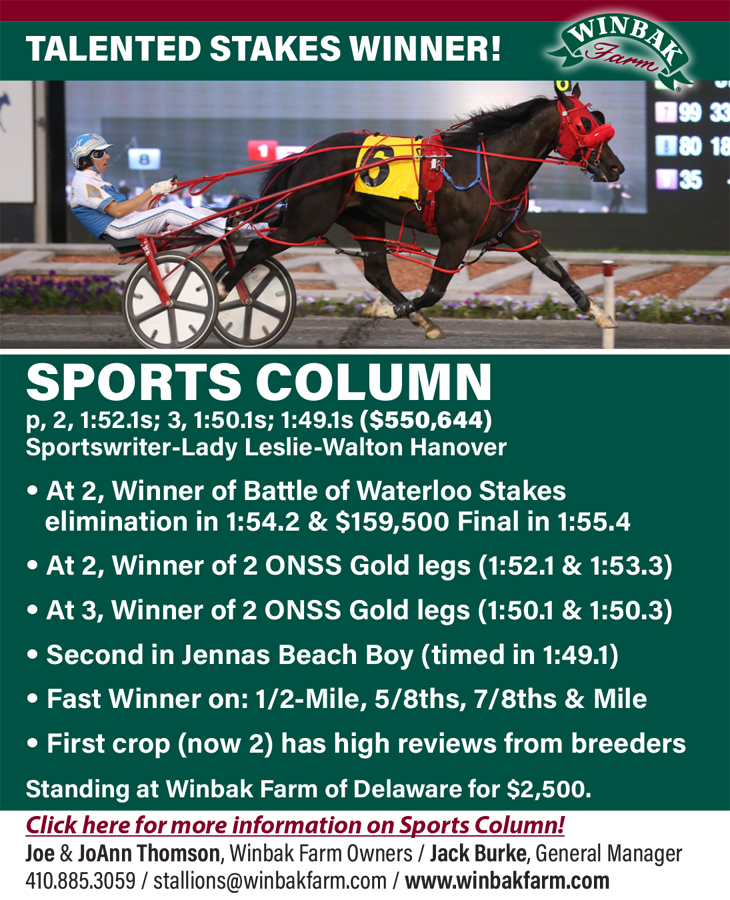Does a driver’s weight makes a difference, should you keep x-raying yearlings after purchase, should Tony Morgan be in the Hall of Fame and will the Mohawk Million ruin the sport?
Answers to all that and more in this week’s edition of the sport’s most popular advice column.
by Ron Gurfein
Tidbits: If you have an addictive personality STOP reading this paragraph now.
A few weeks ago I suggested reading a crazy Jeff Lindsay novel Just Watch Me. I have since learned that he had written an eight-season series called DEXTER, that I have binge watched through the first six seasons already. It’s as crazy as the novel and a bit too gorey, but it continues to suck you in to keep watching. Dexter is a serial killer that only kills bad guys and has more escape routes than Jack Bauer of 24 fame.
* * *
It looks like there is an excellent chance that the Commonwealth of Kentucky will pass a sports betting bill in the near future. The bill was passed in committee 137 to 0. As of this writing it seems they have enough votes to pass and Kentucky’s newly-elected governor Andy Beshear is a champion of the bill.
The bill would allow Kentucky horse tracks and Kentucky Speedway to apply for gaming licenses at a cost of $500,000 initially and $50,000 per year thereafter.
Robert Sturman asks: (this is a reduced form of a novel he wrote me that I have reframed as a short question) Will the destructive thought process behind the Mohawk Million prove to be the final nail in this sport’s coffin? Imagine the NFL allowing the Patriots, Eagles and Cowboys to pool their assets and compete against the rest of the league.
I think harness racing has become a sport of, for and by the elite.
I spent a long time thinking about this before I put pen to paper and realize that you are not the only one that has echoed these sentiments to me in recent weeks. My take on the matter is quite different. I am not sure you are correct in thinking the Mohawk Millions is bad for the sport. I feel any grandiose plan executed properly is a major plus to the sport. This race doesn’t hurt the small trainer or owner as you say because they don’t have the money to compete, but look at the big picture and think that the small trainer may pick up some new owners because of the wonderful publicity that will come out of the extravaganza.
That said, I will say that the people who will get the least of the situation are the participants. They are putting up all the purse money and in addition they are paying for a free ride for one other. This format is much like the million-dollar All American Futurity at Ruidoso Downs for quarter horses. I am not sure but I think the starting fee was $100,000.
I heard through the grapevine that the Mohawk Million spots were all sold and there was a waiting list.
It just shows the tremendous financial shape harness racing is in in 2020. We have come a long way.
Look back at the Grand Circuit from the inception, at the top this is an elitist sport and always has been to some extent. We didn’t have the Phipps, Vanderbuilts, and Whitneys, that was traditional “old money.” We had some, but we also had lots of new money. And what’s so terrible about elitist? It gives the little guy something to strive for.
There are many Hall of Famers that had meager beginnings yours truly, Joe Holloway and Linda Toscano come to mind. We were all minnows watching the whales in our early years. I started training in the mid-1960s, won my first Grand Circuit race with Higher Power in the 1982 Adios (17 years later) and didn’t win another till the late 1980s when Franconia won the Maple Leaf Trot at Greenwood.
I truly hope the Mohawk Millions is a tremendous success and other tracks follow suit. Hopefully, if new races develop from this scenario, the tracks will put up some of their money for the purses.
The trend toward dropping the elimination races format will certainly increase the available Grand Circuit dates and make room for many more racing opportunities.
Tom Santoro asks: Does the driver’s weight make a difference?
For sure it does when you are comparing drivers of equal talent. I remember Marvin Maker at Liberty Bell when he just started driving. There were many 180lb guys in that driving colony and when “ the mouse” who weighed 115lbs. soaking wet jumped on one of their previous drives, records would fall. I put Marvin down on a trotter that was doing okay in his class trotting around 2:07 week after week. Marvin put him on the front end and he won by many open lengths in 2:03. The previous driver who was sitting in the drivers’ room not far from me took his whip and threw it at the glass window, no damage but amusing.
In my lifetime, there were plenty of excellent big drivers but few if any remain today. It is a light weights sport today. The top drivers probably average 140 lbs. many in the 130s. Jody Jamieson and Cory Callahan come to mind as the biggest I can think of and in no way do they resemble the big guys of the past such as Eddie Davis or Eddie Cobb.
Cat Manzi to me was the greatest big driver, certainly not fat but quite tall and he knew the secret of being bigger and remaining competitive. He was very still in the bike and on top of that he was very intelligent.
Charles Foster asks: I read your opinion on pre-sale x-rays (full story here). What are your thoughts on routinely x- raying yearlings immediately after their purchase to identify issues like OCDs etc. or do you prefer to wait till something shows up in training?
Without question you should x-ray right after purchase. The sooner you remove OCDs etc. the better chance you have of a successful
racing campaign. Waiting for something to rear its ugly head is just asking for trouble. Very important note, don’t let anyone talk you out of operating because the OCD is not on a weight bearing surface, that has happened to me and it came back to bite me you know where.
Ray Hanna asks: Tony Morgan winner of 15,000 races is not in the Hall of Fame what are your thoughts on this?
Tough question to answer. I know Tony very well. He is smart and was a leader and an innovator on the Illinois circuit for a long time. He was the first catch driver that I had met that had his own bike. It was the old Chicago underslung and I am not sure if it was because he liked the bike itself or he was so tall that he wasn’t as comfortable in the others. Tony was to Illinois as Joe Napolitano is to Pennsylvania. Both very mild mannered and quiet, no showboating, just doing their job in the talented way they always do. He never spent much time away from his home track in Illinois or the Pennsylvania, Delaware circuit. I am sure he has been nominated but he hasn’t been enough of a fixture in Grand Circuit competition to plant the seed in the minds of the selection committee.
A lot has changed in the last few years in that regard which does bode well for the chance of his selection, so if you are a fan keep your fingers crossed it just might happen.
Susan Brown asks: I was wondering what you think about sickle hocked and cow hocked horses. I have a super bred pacer that is both what is your opinion?
One of the greatest trainers, if not the greatest of all time, Billy Haughton, always said that sickle hocked pacers are usually very fast. That said, for the most part I spent most of my life buying trotters and personally not fond of either characteristic. I have found that many yearlings that are cow hocked become straighter as the get older. I would buy a cow hocked pacer or a sickle hocked pacer way before a trotter. I don’t even like to look at a sickle hocked horse they look strange to me. The brother to Father Patrick that I advised Lindy Farm to purchase from Hanover was ever so slightly sickle hocked and it bothered me so much — even though I loved the colt — that we went back to look at him three or four times being extra careful.
In the case of your pacer, if you are happy with his gait, I am sure he will overcome the minor conformation problems you have spoken of. Best of luck with him.
Thanks again to all of you for your kind words. I want all the naysayers that accuse me of being too positive about the situation our sport is in to take note that the Tattersalls Winter Mixed Sale at the Meadowlands Monday was up 41 per cent over last year’s average and the gross was up $1million with 22 fewer horses selling. In addition, Lindy The Great, the sales topper at $450,000 and purchased by Rene Allard, was the highest price for a horse sold at that venue in the past 10 years. Please keep the questions coming in and have a wonderful week.
Have a question for The Guru?
Email him at GurfTrot@aol.com.

















